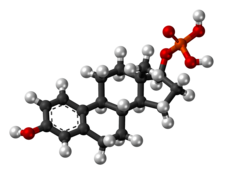聚磷酸雌二醇(Polyestradiol phosphate),簡稱PEP,藥品名稱Estradurin,是用來治療男性前列腺癌的雌激素藥品[1][9][2][10]。也可以用來作為治療女性的乳癌、是治療低雌激素症及更年期症狀的激素替代療法藥物之一,也是給跨性別女性的女性化賀爾蒙治療[1][11],以每4個星期一次肌肉注射的方式給藥[1][2][12]。
 維基百科
維基百科中的醫學內容
僅供參考,並
不能視作專業意見。如需獲取醫療幫助或意見,請諮詢專業人士。詳見
醫學聲明。
Quick Facts 臨床資料, 商品名(英語:Drug nomenclature) ...
Close
Mikkola A, Ruutu M, Aro J, Rannikko S, Salo J. The role of parenteral polyestradiol phosphate in the treatment of advanced prostatic cancer on the threshold of the new millennium. Ann Chir Gynaecol. 1999, 88 (1): 18–21. ISSN 0355-9521. PMID 10230677. Orchiectomy and estrogens have been used for over 50 years in the treatment of advanced prostatic cancer. Although orchiectomy is a simple procedure, it may cause psychological stress. Oral estrogen therapy is as effective as orchiectomy in terms of cancer inhibitory effect, but its acceptance as primary hormonal treatment is overshadowed by an increased risk of cardiovascular complications. Parenteral estrogen, polyestradiol phosphate (PEP), is effective, but also associated with cardiovascular complications, although to a lesser extent. During the last 20 years, well tolerated luteinizing hormone releasing hormone (LHRH) analogues have been replacing orchiectomy and estrogens. Efforts have been made to increase the efficacy of the treatment by adding antiandrogens to LHRH analogues and also to orchiectomy (combined androgen blockade, CAB). However, the efficacy of LHRH analogues and CAB has not proved to be superior to that of simple orchiectomy and, moreover, they are expensive treatment modalities. Orchiectomy and LHRH analogues are associated with negative effects on bone mass and may cause osteoporosis, whereas PEP treatment has an opposite effect. Parenteral polyestradiol phosphate is still a cheap potential treatment for advanced prostatic cancer, but further studies should be conducted to establish its future role, e.g. combining acetylsalicylic acid to prevent cardiovascular complications.
Michael Oettel; Ekkehard Schillinger. Estrogens and Antiestrogens II: Pharmacology and Clinical Application of Estrogens and Antiestrogen. Springer Science & Business Media. 6 December 2012: 261,544 [2021-01-26]. ISBN 978-3-642-60107-1. (原始內容存檔於2021-03-07). Natural estrogens considered here include: [...] Esters of 17β-estradiol, such as estradiol valerate, estradiol benzoate and estradiol cypionate. Esterification aims at either better absorption after oral administration or a sustained release from the depot after intramuscular administration. During absorption, the esters are cleaved by endogenous esterases and the pharmacologically active 17β-estradiol is released; therefore, the esters are considered as natural estrogens.
Stege R, Carlström K, Hedlund PO, Pousette A, von Schoultz B, Henriksson P. Intramuskuläres Depotöstrogen (Estradurin) in der Behandlung von Patienten mit Prostatakarzinom. Historische Aspekte, Wirkungsmechanismus, Resultate und aktueller klinischer Stand [Intramuscular depot estrogens (Estradurin) in treatment of patients with prostate carcinoma. Historical aspects, mechanism of action, results and current clinical status]. Urologe A. September 1995, 34 (5): 398–403. ISSN 0340-2592. PMID 7483157 (德語). More than 50 years ago, orally given estrogen was already used in the treatment of prostate cancer. Due to cardiovascular side-effects with a high morbidity of 25%, this treatment has not become standard. Recent investigations show that parenteral application reduces the risk of cardiovascular side-effects, because it avoids the first passage through the liver with high concentrations of estrogen which normally occur after oral application. Therefore, an increased synthesis of so-called "steroid-sensitive" liver proteins, such as coagulation factors (especially factor VII) can be avoided. This newer parenteral estrogen application shows encouraging results of a cheap and effective hormonal therapy with a low rate of side-effects in patients with prostate cancer.
Mikkola, A; Aro, J; Rannikko, S; Ruutu, M; Finnprostate, Group. Ten-year survival and cardiovascular mortality in patients with advanced prostate cancer primarily treated by intramuscular polyestradiol phosphate or orchiectomy. Prostate. March 2007, 67 (4): 447–55. PMID 17219379. S2CID 20549248. doi:10.1002/pros.20547.


